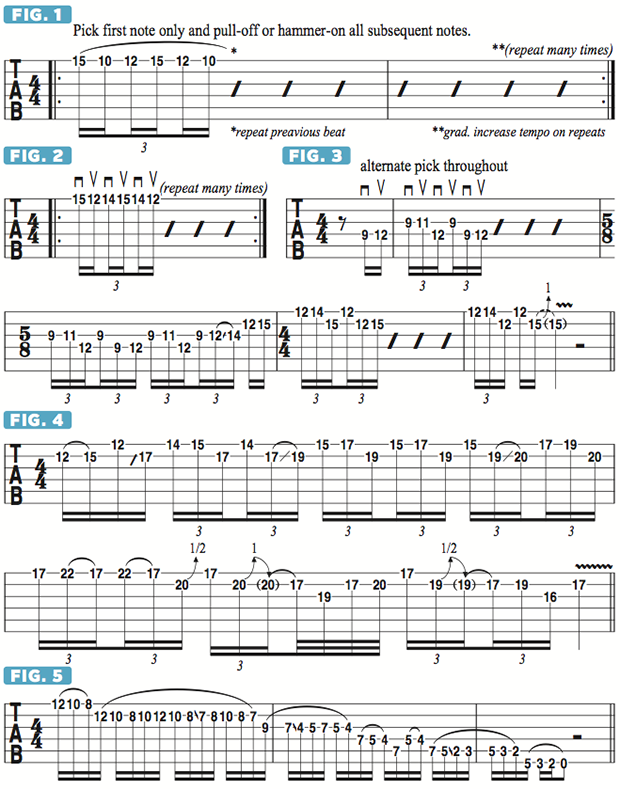Steel Panther's Satchel: Tips for Keeping Your Chops Warmed Up and Razor Sharp
A question I’m often asked, aside from, “How can you possibly be that good looking?” is, “What do you do to warm up?”
Personally, I don’t think about warming up that much, maybe not as much as most players do. But we’ve been touring a lot lately, and, especially in Europe, there just aren’t any heaters anywhere.
So, basically, I am freezing all day log. Then I’m given a guitar five minutes before we go onstage, and I’m expected to be able to burn right from the start! And there I am, frozen to the bone. So I will usually grab my guitar a few minutes before the show and play through a bunch of the riffs and patterns illustrated in this month’s column.
It’s good to have your fingers warmed up a little for when that first solo comes along in the first song, so one of the things I like to warm up with are legato exercises, where I’ll pick the string once and then sound a long series of notes in a repeating phrase using only hammers-ons and pull-offs.

A good example of something I’ll warm up with is the lick shown in FIGURE 1, which is a repeating six-note sequence performed entirely on the high E string. Play the lick over and over, speeding up and slowing down while striving to articulate every note as clearly as possible. The first note, G, 15th fret, is fretted with the pinkie, followed by a pull-off to D, 10th fret, fretted with the index finger.
I then hammer onto the 12th fret with my middle finger to sound E, followed by another hammer up to the initial G note, and then a double pull-off back down the string to E and D. The sequence then repeats on each subsequent downbeat, but I hammer-on back up to the initial high G, so that the rest of the phrase is performed entirely with hammers and pulls, which is great for developing good fret-hand “traction.”
You can apply a similar approach to alternate-picked licks, which is a great way to work on synchronizing your two hands! FIGURE 2 shows a similar rhythmic pattern but with the notes G, F# and E, fretted with the ring, middle and index fingers, respectively. Again, try to articulate each note as clearly as possible, and gradually increase tempo as the phrase repeats.
Another twist on this type of exercise is shown in FIGURE 3. Again using my index, middle and ring fingers, I start out playing a repeating note sequence on the D and G strings. At the end of bar 2, I quickly slide and shift from ninth position up to 12th position and proceed to play the same pattern one octave higher on the B and high E strings.
Let’s take this idea a step further: as shown in FIGURE 4, I repeatedly slide up the fretboard as the line progresses; in FIGURE 5, I move between the pinkie and middle and index fingers to descend the fretboard using multiple hammer-ons and pull-offs, picking only when I switch to a lower string. Work through these patterns slowly at first, then speed them up and try devising some useful warm-up patterns of your own.
Get The Pick Newsletter
All the latest guitar news, interviews, lessons, reviews, deals and more, direct to your inbox!









![Joe Bonamassa [left] wears a deep blue suit and polka-dotted shirt and plays his green refin Strat; the late Irish blues legend Rory Gallagher [right] screams and inflicts some punishment on his heavily worn number one Stratocaster.](https://cdn.mos.cms.futurecdn.net/cw28h7UBcTVfTLs7p7eiLe.jpg)
